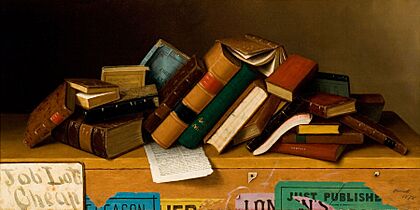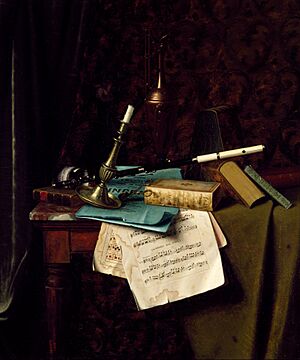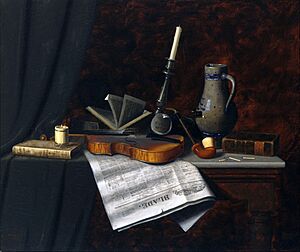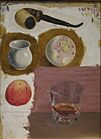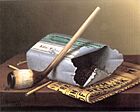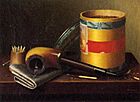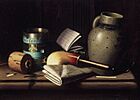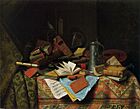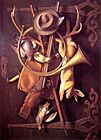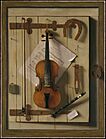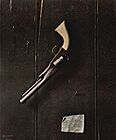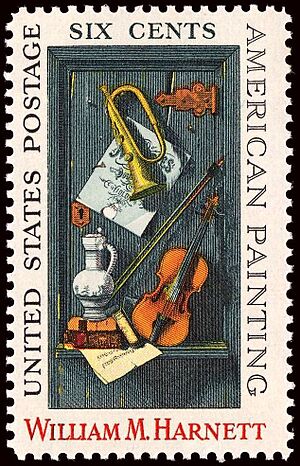William Harnett facts for kids
Quick facts for kids
William Harnett
|
|
|---|---|
| Born | August 10, 1848 Clonakilty, County Cork, Ireland
|
| Died | October 29, 1892 New York City, US
|
| Known for | still life |
| Style | trompe-l'œil |
William Michael Harnett (born August 10, 1848 – died October 29, 1892) was an American painter. He was famous for his amazing trompe-l'œil (pronounced "tromp loy") still life paintings. These paintings made everyday objects look incredibly real.
Contents
Early Life and Art Training
William Harnett was born in Clonakilty, County Cork, Ireland. This was during a very tough time called the Great Famine. His father worked as a shoemaker.
Soon after William was born, his family moved to America. They settled in Philadelphia. William became a United States citizen in 1868.
When he was seventeen, he started learning how to engrave. From 1865 to 1875, he made a living by engraving designs on silver items. He worked for companies like Tiffany and Company in Philadelphia and later in New York City.
During these years, he also took art classes at night. He studied at the Pennsylvania Academy of the Fine Arts. Later, in New York, he attended Cooper Union and the National Academy of Design. His first oil paintings were made in 1874. These included studies of plaster statues and his first finished still-life painting, Paint Tube and Grapes.
Harnett's Unique Paintings
William Harnett created a special style of trompe-l'œil painting. This style made things look so real, it "tricked the eye." Many artists tried to copy his work.
This type of painting wasn't completely new. Some Dutch painters from the 1600s, like Pieter Claesz, were very good at painting realistic tabletop still life scenes. In America, Raphaelle Peale started this style in the early 1800s.
What made Harnett's art special was his incredible skill. He also chose to paint objects that usually weren't seen in art. He painted musical instruments, hunting game, and drinking mugs. But he also painted unusual things like Golden Horseshoe (1886). This painting showed a single rusty horseshoe nailed to a board.
He also painted a messy pile of old books on a crate, called Job Lot, Cheap (1878). He even painted firearms and paper money.
Artistic Recognition and European Travels
Harnett's paintings sold well to business owners. They were often displayed in offices, stores, and taverns. However, art critics at the time didn't always see them as "high art." When his paintings were shown in museums, they were sometimes called just "novelties."
Harnett lived in Europe from 1880 to 1886. He spent most of this time in Munich, Germany. His most famous paintings are the four versions of After The Hunt. He painted these between 1883 and 1885.
Each After The Hunt painting shows hunting gear and dead game hanging on a door. These paintings are great examples of trompe-l'œil. The objects seem to pop out because they are painted in a shallow space. This means the illusion still works even if you move your head.
Harnett's work is often compared to that of John F. Peto, another artist who was a bit younger. They knew each other. You can see their different styles by looking at their violin paintings.
Harnett's Music and Good Luck (1888) shows a violin hanging neatly on a door. There's a slightly torn piece of sheet music behind it. Everything looks organized and stable. Peto's 1890 painting shows a violin hanging crooked. It looks chipped and worn, with a broken string. The sheet music is crumpled and torn. Harnett's objects look used but well-cared for. Peto's objects look more humble and worn out.
After both artists had passed away, experts studied their paintings. They found that many of Peto's paintings had fake signatures of William Harnett.
Later Years and Legacy
In his last years, William Harnett suffered from severe rheumatism. This made it harder for him to paint. But the quality of his paintings remained high.
He passed away in New York City in 1892. He was buried in Philadelphia, Pennsylvania. Other artists who painted in a similar style include John Haberle, Otis Kaye, Jefferson David Chalfant, and Richard La Barre Goodwin.
Where to See Harnett's Art
You can find William Harnett's paintings in many art museums. Some of these include:
- The Munson-Williams-Proctor Arts Institute in Utica, New York
- The Albright-Knox Art Gallery in Buffalo, New York
- The Amon Carter Museum in Texas
- The Dallas Museum of Art
- The Art Institute of Chicago
- The Brooklyn Museum of Art
- The Carnegie Museum of Art in Pittsburgh
- The Cincinnati Art Museum
- The Cleveland Museum of Art
- The Detroit Institute of Arts
- The Fine Arts Museums of San Francisco
- Harvard University Art Museums
- The High Museum of Art in Atlanta, Georgia
- The Honolulu Museum of Art
- The Joslyn Art Museum in Nebraska
- The Los Angeles County Museum of Art
- The Metropolitan Museum of Art in New York
- The National Gallery of Art in Washington D.C.
- The National Gallery of Canada in Ottawa
- The Philadelphia Museum of Art
- The San Diego Museum of Art in California
- Thyssen-Bornemisza Museum in Madrid
- The Toledo Museum of Art in Ohio
- The Wadsworth Atheneum in Connecticut
- The Wichita Art Museum
Gallery
-
Attention, Company!, 1878, Amon Carter Museum, Fort Worth
-
Study of a Pipe and Other Objects, De Young Museum, 1874
-
A Smoke Backstage, by William Michael Harnett, oil on canvas, 1877, Honolulu Museum of Art
-
Still Life, Chrysler Museum of Art, 1877
-
Music and Literature, Buffalo AKG Art Museum, 1878
-
Still Life with Three Castles Tobacco, 1880, Brooklyn Museum
-
After the Hunt, 1883, Huntington Library, San Marino, CA
-
After the Hunt, 1884, Butler Institute of American Art, Youngstown, Ohio
-
After the Hunt, 1885, California Palace of the Legion of Honor, San Francisco
-
The Old Violin, 1886, National Gallery of Art, Washington, DC.
-
Music and Good Luck, 1888, Metropolitan Museum of Art
-
The Faithful Colt, Wadsworth Atheneum, Hartford, Connecticut, 1890
Harnett's Commemorative Stamp
William M. Harnett was honored in 1969 with a special U.S. commemorative stamp. This stamp was first sold in Boston, Massachusetts. The painting shown on the stamp is Old Models. This painting is part of the collection at the Boston Museum of Fine Arts.
See also
 In Spanish: William Harnett para niños
In Spanish: William Harnett para niños



